All forms of life require water, and simple and effective solar-powered desalination is the key. Water covers approximately 70 per cent of the Earth’s surface, yet the accessible traditional freshwater resources, including lakes, ponds, and creeks account for less than 0.3% of the total (Li et al., 2021). Projections suggest the global population will reach 9.9 billion people by 2050, with half of the world’s population potentially living in water-scarce regions by 2025. Finding a new water source is dire.
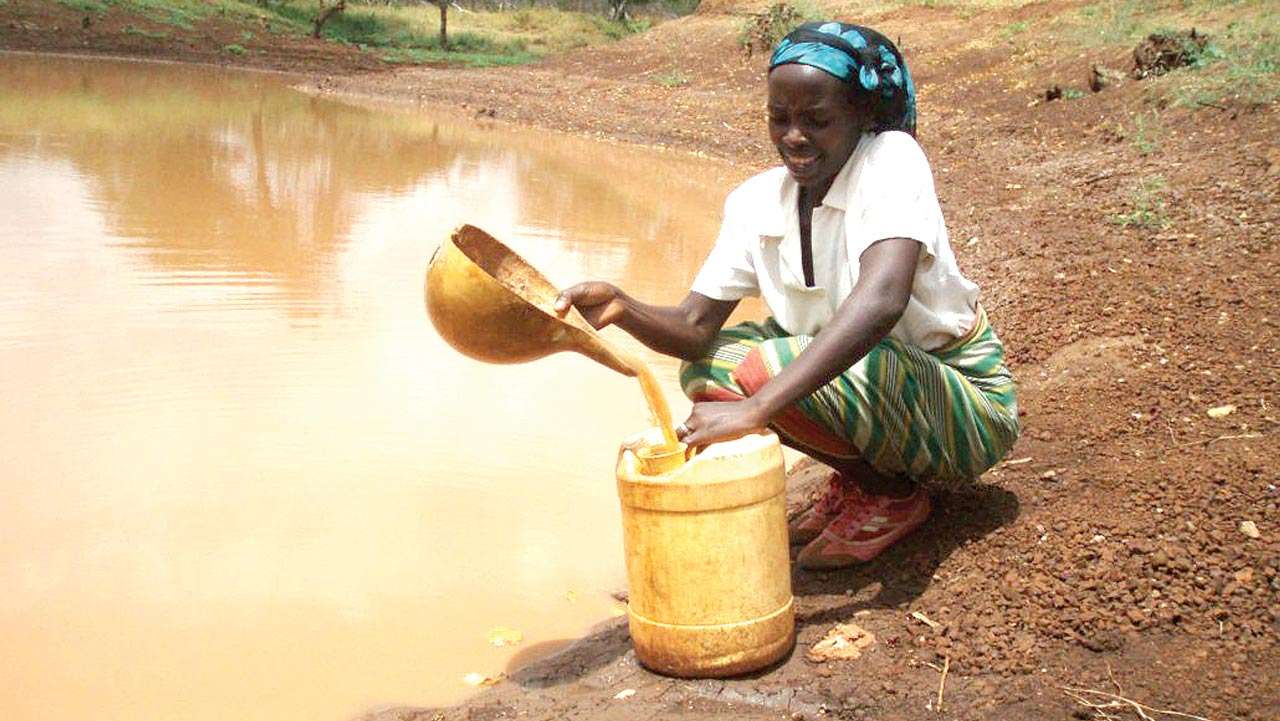
Source: The Guardian
What is Desalination?
Desalination is any process that removes excess salt and other harmful minerals from water. Its purpose is to make fresh water suitable for humans to consume, or to use for domestic and industrial purposes. Currently, there are over 18,000 desalination plants in more than 150 countries, supplying around 87 million cubic metres of fresh water to over 300 million people every day.
A Simple And Effective Alternative
Desalination is becoming a popular sustainable water delivery method in many towns and industries. Its adoption greatly affects the socio-economic development of developing nations, particularly in water-constrained regions like Africa, Asia, and the Middle East. Thanks to technological improvements, desalination is now substantially more affordable, allowing certain nations (such as Qatar and Kuwait), to completely rely on it for both residential and industrial uses.
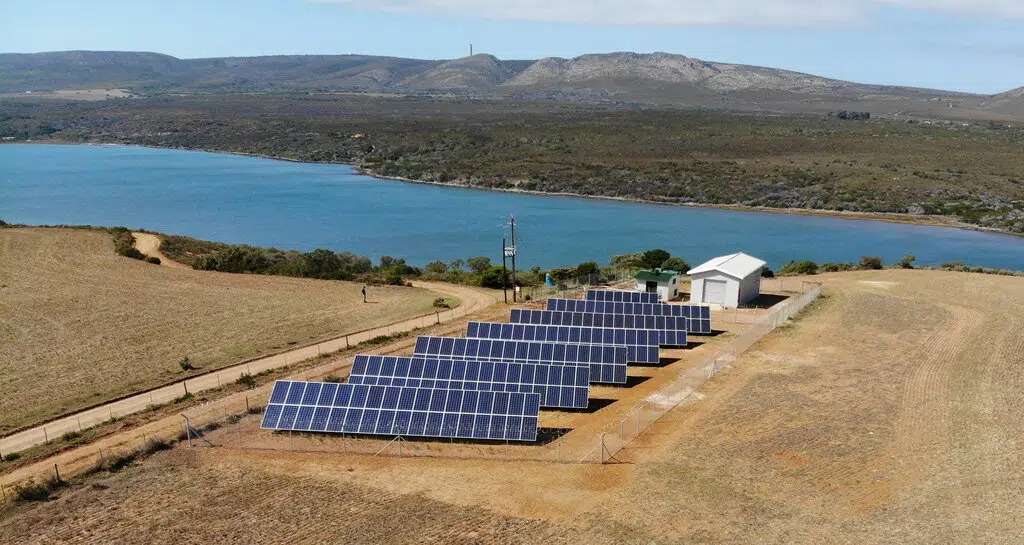
Source: Earth.Org
What is solar-powered desalination?
Solar-powered desalination refers to a technique to desalinate water using solar energy. Humans use these solar energy systems in remote locations, developing countries, and for disaster relief. Hence, the considerable advantage of these systems is that they can stand alone, not requiring a connection to grid electricity.
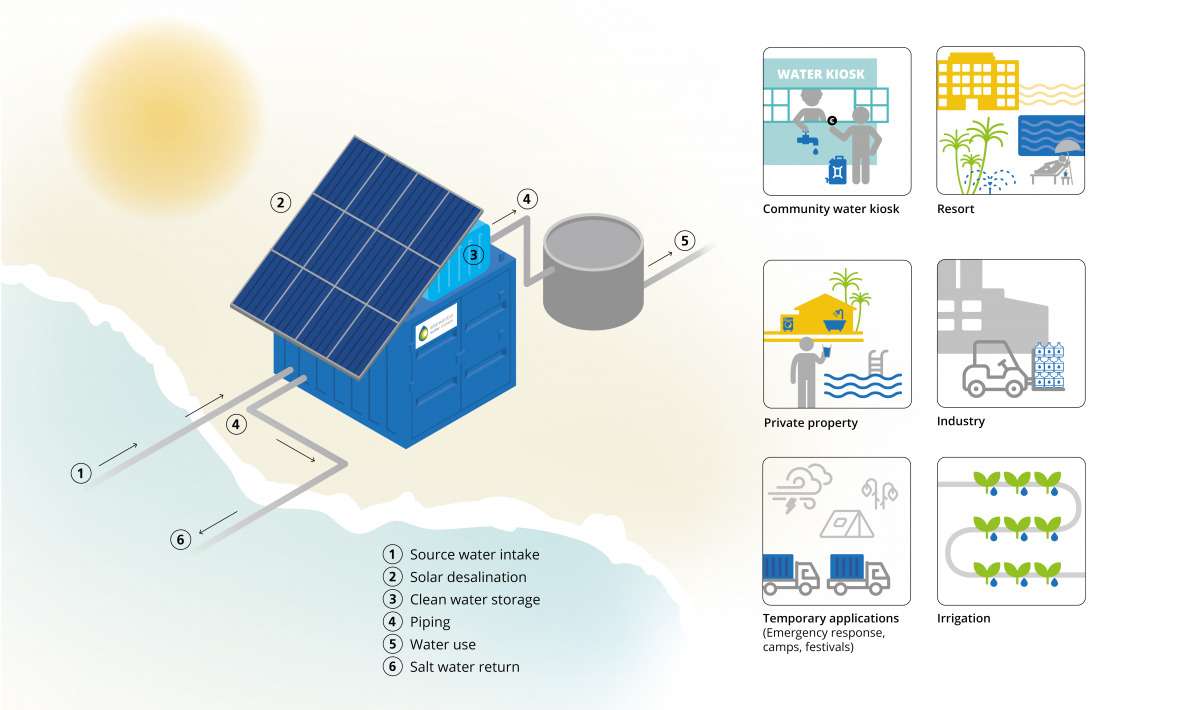
Source: Elemental Water Makers
simple and effective Solar Desalination Technologies
In essence, desalination plants can be operated either directly or indirectly with solar energy. In systems that use direct solar desalination, we apply solar energy to generate distilled water in the solar collector. Indirect solar desalination systems use solar thermal collectors to harvest solar energy, rendering solar energy the most widely used technology.
Thermal and Membrane Desalination Technologies
- Multi-effect desalination (MED)
- Multi-stage flash desalination (MSFD)
- Membrane distillation (MD)
- Reverse osmosis (RO)
These take the form of flat plate solar collectors, evacuated tube solar collectors, and parabolic trough solar collectors. Each provides either heat or photovoltaic panels to generate electricity (Zhang et al., 2018). The most effective desalination method currently available is reverse osmosis.
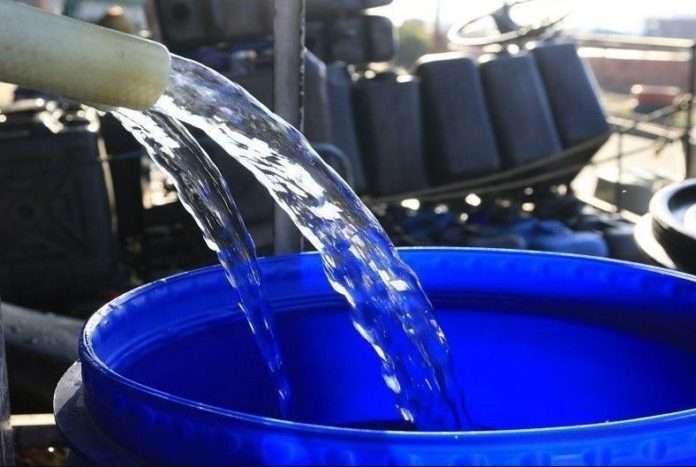
Source: Pumps Africa
Is This A Simple and effective, sustainable route?
Harnessing solar energy to power water treatment processes emerges as a potentially sustainable solution to address the global water scarcity problem. Despite significant reductions in desalination costs, due to market maturity and technological advancements, there are critical issues that require effective resolution before considering desalination as an integrated sustainable option.
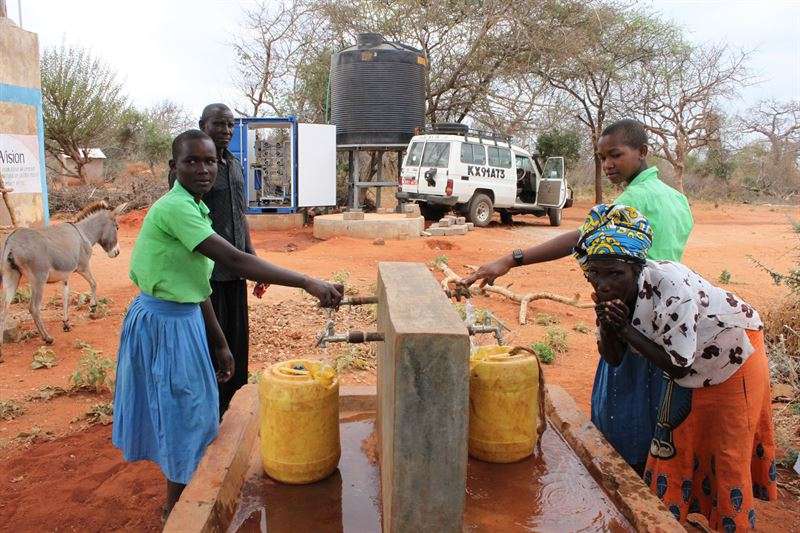
Source: News By Cision
Energy Considerations
Energy is the most critical factor affecting the extent and feasibility of desalination. Between 30% and 50% of the cost of water produced by desalination processes is related to energy. According to the World Energy Outlook of 2016, in the Middle East, the water sector’s share of total electricity consumption is expected to increase from 9% (in 2015) to 16% (by 2040). This is purely because of a rise in desalination capacity. Desalination has negative impacts in the form of the depletion of fossil fuels and GHG emissions from the power production process.
Brine Concentrate Consideration
Brine is a high-concentration solution of salt in water and is a by-product of many industrial processes, including desalination. The simplest way to dispose of brine is to return it to the ocean. However, high localised brine concentrations raise seawater salinity and alkalinity to the point that an environmental risk is created.
About 142 million cubic meters of brine, the salty slush, generated through the creation of drinking water, are returned to the sea every day. Saudi Arabia, the United Arab Emirates, Kuwait, and Qatar are responsible for 55 per cent of global brine production.
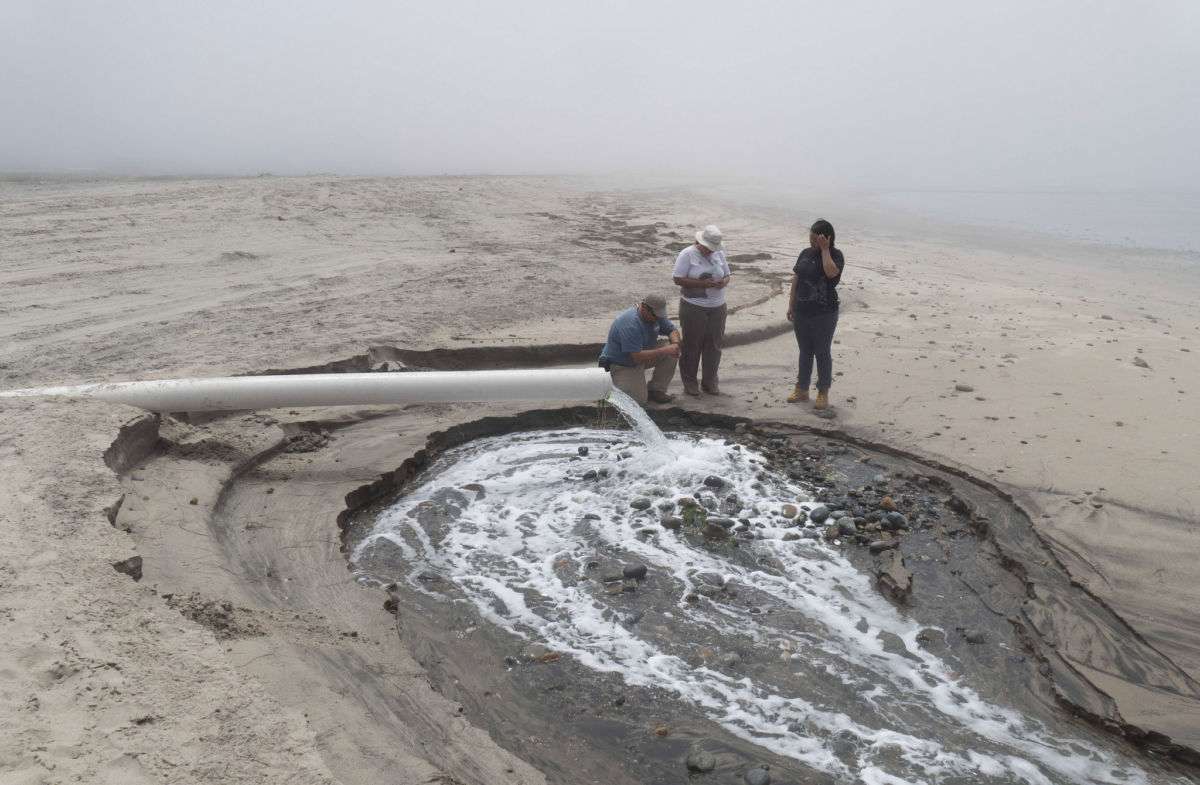
Source: Flickr
Additionally, due to its dense concentration, brine sinks and spreads along the sea floor, where it can interfere with entire marine ecosystems. It is particularly harmful in semi-closed seas such as the Persian Gulf. When discharged into the ocean for seashore desalination facilities, this effluent creates serious management issues. There are also notable problems with underground aquifers for inland desalination plants (Xevgenos et al., 2014).
The United Nations Mediterranean Action Plan (UNMAP) has recognised the problem with brine disposal as one of the major threats to the Mediterranean Sea. More specifically, one of the most significant seagrasses of the Mediterranean Sea (Posidonia Oceanica) is protected under the Barcelona Convention. It is highly vulnerable to salinity changes as a result of brine exposure (Palomar and Losada, 2011; Riera et al., 2012).

Source: Siemens
Simple and Effective Cost Considerations
The capital costs in simple and effective solar-powered desalination technologies are still high, and active research and development are presently ongoing to increase productivity. A reduction in cost is anticipated due to technology improvements, learning effects, and scaling-up.
The integration of solar systems and desalination technologies are sustainable solutions for addressing power and water challenges. Offering the advantage of cogenerating electricity and fresh water. It is anticipated that the utilisation of concentrated solar power will lower desalination water costs compared to independent desalination plants. However, this approach is most suitable for medium- to large-scale solar desalination applications (Zhang et al., 2018).
The Application of solar energy in water treatment processes
The application of solar energy in water treatment processes includes groundwater, surface water, brackish/ seawater desalination, rainwater harvesting/treatment, and greywater treatment/reuse. It also includes stormwater treatment/reuse, wastewater treatment/reuse water treatment technologies, screening, filtration, softening/ion exchange, microfiltration, and ultrafiltration. Finally, solar energy can also be applied with reverse osmosis, biological treatment and disinfection.
Public Water Supply Sources
In 2015, various parts of the U.S.A actively incorporated desalinated seawater or brackish groundwater that was treated to reduce dissolved solids into their public water supply sources. The U.S. Virgin Islands, Texas, Florida, and Massachusetts reported a combined total of 7.21 million gallons per day of withdrawals of saline surface water for public supply use. Furthermore, a combined total of 263 million gallons per day of saline groundwater withdrawals for public-supply use were identified for Florida, California, Texas, Virginia, Kansas, and Utah (Deiter et al., 2018).
Agricultural Purposes
Several countries, including Spain, Kuwait, and Saudi Arabia actively utilise desalinated water for agriculture. While Italy, Bahrain, Qatar, the USA, and Israel actively employ desalinated water for food production. In 2018, South Africa took the lead by installing the first solar-powered desalination plant on the continent, with another four plants in the pipeline. This pioneering facility generates 150,000 litres of potable water per day. Following this groundbreaking example, Namibia, Kenya, and Uganda have also initiated solar-powered desalination plants. In order to produce safe water for drinking and irrigation purposes.
moving forward: simple and effective water Usage
The connection between SDG 6 and SDG 7 is increasingly evident when looking at global water usage patterns. Utilising solar energy to tap into alternative water resources emerges as a promising option to mitigate the risk of a water crisis. Additionally, the incorporation of batteries strengthens the feasibility of solar desalination.
Meanwhile, to minimise the environmental impact, it is necessary to actively pursue additional applications and research. In this vein, we might efficiently manage the brine concentrate generated by desalination plants. The goal is to obtain reusable clean water while producing a new form of brine, either as a highly concentrated sludge (aiming for minimal liquid waste) or as a completely solid waste (achieving zero liquid discharge).
achieving the United Nations Sustainable Development Goals (SDGs)
Achieving Sustainable Development Goal 6 (clean water and sanitation) is critical. Meeting this target by 2030 will be difficult, particularly in the Global South. Humans in the Global South are more likely to contract diseases caused by water. Science is at the heart of sustainable development and is our ticket to finding new ways to address the SDGs. These goals focus on transforming the world by providing a shared blueprint for peace and prosperity and a plan of action or global collaborative partnership.
A Thrivable Framework
At THRIVE, we believe in every action that protects water resources. This includes the efficient management and distribution of water. We need to take action as our health and well-being depend on it. It’s also important we also look at our own responsible consumption and steps we can take to help save water.
Knowing that every step we take will lead to a thrivable planet. Altogether, we recognise that the pursuit of human happiness can sometimes compete with environmental well-being. Accordingly, the increasing development of renewable energy sources in water-scarce regions has led to desalination as a simple and effective option to mitigate water scarcity and lead to an adaptation to climate change.
If you would like to know more about sustainable water management, water purification, or recycled water, many useful articles are available. To learn more about how THRIVE is researching, educating, and advocating for a future beyond sustainability, please visit our website, or listen to our informative podcast series.























